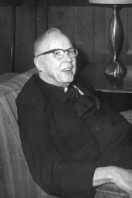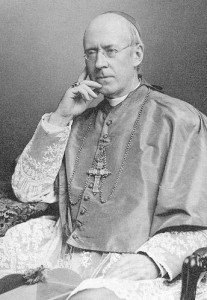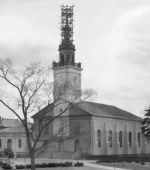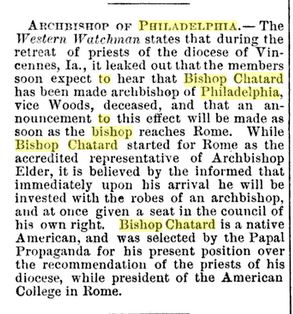March is a very busy month in Indiana Catholic History. With that in mind, there are a number of items that I wanted to post from the calendar that are very important to our collective history.
March 22nd is the anniversary of the death of Monsignor John J. Doyle. Msgr. Doyle was born in Indianapolis on March 13, 1898.  He attended St. Joseph’s Parish, which was then located on the corner of North Street and College Avenue and is now a local brewery and restaurant. He attended St. Meinrad and was ordained on May 17, 1921 Msgr. Doyle, known to many as the “Mons” spent most of his career as a professor at Marian College in Indianapolis. After his retirement, Monsignor Doyle became the Archivist and Historian of the Archdiocese of Indianapolis. He contributed much to the understanding of Indiana Catholic Church History. In 1976 he published “The Catholic Church in Indiana 1686-1814“. In 1978 he published “Genealogical Use of Catholic Records in North America” for the Indiana Historical Society. Msgr. Doyle’s love of history, especially his love of history of the Church in Indiana always showed through.
He attended St. Joseph’s Parish, which was then located on the corner of North Street and College Avenue and is now a local brewery and restaurant. He attended St. Meinrad and was ordained on May 17, 1921 Msgr. Doyle, known to many as the “Mons” spent most of his career as a professor at Marian College in Indianapolis. After his retirement, Monsignor Doyle became the Archivist and Historian of the Archdiocese of Indianapolis. He contributed much to the understanding of Indiana Catholic Church History. In 1976 he published “The Catholic Church in Indiana 1686-1814“. In 1978 he published “Genealogical Use of Catholic Records in North America” for the Indiana Historical Society. Msgr. Doyle’s love of history, especially his love of history of the Church in Indiana always showed through.
The 25th is the anniversary of the ordination of Father Anthony (Antoine) Deydier who was ordained on Holy Saturday, March 25th, 1837. This was a special time for the Diocese of Vincennes not only because the first ordination in the new Cathedral of St. Francis Xavier had taken place a few weeks earlier, but also because Anthony Deydier, a man who had been ordained a deacon in 1812, was finally being ordained a priest. No one seems to know for sure why Deydier waited so long for ordination, but certainly his association with Brute at Mount St. Mary’s is what led him eventually to his priestly ordination. Deydier was born in 1788 and he left his native France on June 10th, 1810 on the same boat as Simon Brute’. After his ordination to the diaconate he refused ordination to the priesthood and he taught for four years at Mount St. Mary’s eventually ending up in Albany New York as a private tutor. After his ordination as a priest he was sent to Evansville where, except for a money collection tour, he remained. Much of his time was taken up ministering to the workers on the Wabash and Erie Canal. Deydier’s life in Evansville was not one of leisure. Saint Mother Theodore Guerin, foundress of the Sisters of Providence, St. Mary of the Woods, wrote in her journal “œSo extreme was his poverty and so complete his destitution, that I shall run the risk of being accused of exaggeration in describing it.” Deydier also combed the southwestern part of the state, seeking out Catholics. He remained in Evansville until 1859, when he retired to the”Highlands” at Vincennes. He died in 1864 and is buried there.
March 25th also marks the 1736 death of Father Antonius Senat S.J. On that date, which was Palm Sunday in 1736, Fr. Senat was burned at the stake by Indians. He was reported to be pastor of St. Francis Xavier, in Vincennes, according to Cauthorn’s “nine epochs in the history of St. Francis Xavier” 1
Fr. Senat had been pastor at Kaskaskia, which is where many missionaries had come to Vincennes from. However, it is doubtful that he ever actually visited the post at Vincennes. He accompanied the troops, including the “Sieur de Vincennes” who had gone to fight the Chickasaw Indians. One description, taken from Transactions of the Illinois Historical Society says this:
“Tis malediction I bring to you blessed ones, but I must tell it now and quickly. We went to Fort Prudhomme with the Major, and Vincennes joined us with twenty French and 100 Miamis. We waited long for Bienville; he came not; we waited longer for Moncheval, he was not there. Our maize and hog meat ran short; our Indians were clamorous to begin. We marched alone to the attack. We marched a weary twenty leagues and came to the towns of the Chickasaws; they were awaiting us, and we were forced to attack. We pass two lines of fortification. We are successful but we pay the price. At the third line D’Artaguette falls severely wounded. The Miamis betray us; the Illinois and Missouris run like sheep. They who were so eager to fight are cowards when we need them. We try to drag Father Senat and Vincennes away but they will not come and leave their wounded friend. These, with fifteen others are taken by the fiends. I hang around to try and help them. Bienville attacks from the other side and is defeated with great loss. D’Artaguette,’ Vincennes, Senat and the others remain in the hands of the Chickasaws. Then comes a day of feasting and noise and in the afternoon they bring out the French. They tie them by fours to saplings and (lance the death dance, while I watch from a near by tree. They build piles of hickory poles in circles around them and set fire to the poles, and when the fires burn down they rush in toward them in crowds; they stick them with the hot poles; they discharge their guns loaded only with powder into their bodies. Ali, Jesus. I hear their hateful screams and above all the din the song of Senat as he chanted his requiem mass. My ears ring with it. My eyes burn with the sight until I cannot eat or sleep. And then there was silence and they are all dead-all! all!”
The execution took place in Mississippi. In fact, there is a historical marker located 1-1/2 miles south of Pontotoc, Pontotoc County, Mississippi which says:
PIERRE D’ARTAGUETTE:
“French Commander was defeated in battle with Chickasaw Indians, May 20, 1736. A week later d’Artaguette, Frances Marie Bissat de Vincennes, Father Artaine Senat, Jesuit Missionary, in all 20 Frenchmen captured were burned at the stake by their captors. Father Senat scorning the offer to escape martyrdom remained with his comrades and entoning the Miserere, led them into the destroying flame.”
Erected by the John Foster Society Children of the American Revolution, Columbus, Mississippi 1934 — Bernard Romans Chapter
Msgr. John J. Doyle, mentioned above, in his The Catholic Church in Indiana 1686-1814 has this to say:
The Sieur de Vincennes did not long continue in command of the post that he founded and that came in later years to be called for him. In 1736 he lost his life in a battle with the Chickasaw Indians in what is now the state of Mississippi. Governor Bienville, hoping to crush the Chickasaws and thus gain unimpeded passage on the Mississippi River, planned a concerted attack upon the Indians from the south and- the north. Bienville would lead his troops from New Orleans. He ordered Diron d’Artiguiette, commander at Fort Chartres, to gather the forces of the Illinois district and to meet him. The Illinois contingent was made up of some 140 Frenchmen and 300 Indians. A part of this little army was from the post on the Wabash, led by its young commander. The part played by these men has prompted some to call the expedition Indiana’s first war.
FAILING TO MEET Bienville, who had met with delays, and being nearly out of provisions, d’Artiguiette ordered an attack on a Chickasaw town, in the hope that its store of food would replenish his supplies and that its stockade would affard his men a secure fort to await Bienville’s army. The attack occurred on Palm Sunday, March 25, 1736. It had success at first, but after a while a large force of Chickasaws came forward and overwhelmed the attackers. Fifty or 60 of these were killed and some 20 were carried off wounded. The Chickasaws captured about 20 men and put them to death by burning on the very day of the battle. These included d’Artiguiette himself, who was badly wounded, the officers Pierre St. Ange and Vincennes, and Father Antoine Senat, the Jesuit chaplain.
THERE IS NO REASON to suppose that Father Senat, whom some list among the priests serving at the post on the Wabash, was ever there. It was because of his presence at Kaskaskia, where he was doubtless serving his apprenticeship like d’Outreleau before him, that he went as chaplain on the disastrous expedition that cost him his life. It is likely that his superior thought that this would be good experience for the young man, who had been in the country but a short time. The association of his name with that of Vincennes as a hero on that occasion has led to the mistake that he was the priest at the post on the Wabash. 2
Father Alerding says: “That Father Senat, a Jesuit, was pastor of Vincennes is mere conjecture. Still, it is presumed that he was, for the reason that he accompanied ‘Vincennes’ the commander of the fort…” 3
So, today we honor Fr. Senat who died a martyr’s death. He may have never set foot at Vincennes, but his work contributed to the history of the Catholic Church in Indiana.
On March 26, 1878 Silas Chatard, Rector of the North American College in Rome, became the fifth Bishop of Vincennes and also became known as “Francis Silas Chatard”. His full name and title was: Right Rev. Francis Silas Marean Chatard. Marean being his mother’s maiden name.
 Chatard was born in Baltimore, Maryland on December 13, 1834. He studied to be and became a medical doctor. He then decided to enter the seminary and he was sent to Rome for studies. He was ordained at Rome on June 14, 1862. He was then named the Vice-rector of the American College, and later the rector upon the transfer of William George McCloskey to become bishop of Louisville in 1868.
Chatard was born in Baltimore, Maryland on December 13, 1834. He studied to be and became a medical doctor. He then decided to enter the seminary and he was sent to Rome for studies. He was ordained at Rome on June 14, 1862. He was then named the Vice-rector of the American College, and later the rector upon the transfer of William George McCloskey to become bishop of Louisville in 1868.
Chatard was rector of the American College during the First Vatican Council and many of the American bishops stayed at the college. He was named bishop of Vincennes on March 26, 1878, at which time he took the name Francis Silas. He was consecrated in Rome on May 12, 1878, by Cardinal Alexander Camillus Franchi, assisted by Bishop Santori of Fano, Italy, and Bishop Edward Agnelli, president of the Academia Ecclesiastica at Rome. Enthroned in the cathedral at Vincennes, August 11, 1878. He almost immediately left for Indianapolis where he arrived on August 17, 1878.
Chatard maintained contact with Rome and traveled there often while bishop. He was mentioned prominently as the possible Archbishop of Philadelphia, but that promotion never came.
Chatard died at Indianapolis on September 7, 1918. His body was interred in the crypt of the cathedral of Sts. Peter and Paul in Indianapolis. On June 8, 1976, Bishop Chatard’s remains were transferred from the cathedral, to the Calvary Chapel Mausoleum, Indianapolis.
Here is the New York Times description of the ceremony of installation in Vincennes:
Installation of Bishop Chatard
THE CEREMONIES AT VINCENNES, IND., YESTERDAY THE DIOCESE AND THE NEW BISHOP.
Special Dispatch to the New.York Times.VINCENNES, Aug. 11. To-day, Dr. Chatard, the newly-appointed Bishop of Vincennes, was formally installed by Archbishop PurceIl of Cincinnati, at the Cathedral of St. Xavier. The weather was pleasant and the city, was crowded with visitors from all the surrounding cities. At 10 o’clock a procession of priests passed from the cathedral to the episcopal residence and escorted Dr. Chatard and Archbishop Purcell to the cathedral. The edifice was densely crowded and had been from before 9 o’clock, and hundreds of people were gathered on the sidewalks near the entrance to the cathedral. Upon entering the church the Bishop knelt for a short time in prayer, and was received y Rev. Mr. Guegen, of the cathedral, who presented him, with the crozier and other symbols of his new authority. The Bishop then proceeded to the sanctuary and the celebration of solemn high mass took place, with Rev. Dr.. Chatard as celebrant, Rev. Messrs. Bessonies and Guegen assistants; Fathers Klein and Andran, attendants on the Archbishop, and Revs. P. McDermott and Duddenhausen as chaplains. During the services Archbishop Purcell, in a few well-chosen remarks, introduced Dr. Chatard, who delivered a short address to the people and gave them his blessing. In the afternoon at 2 o’clock a large procession, consisting of the Catholic societies of this city and others from abroad, formed, and escorting the Bishop through the principal streets, returned to the cathedral, when Dr. Chatard conducted the solemn pontifical vespers and gave the Papal benediction. The episcopal residence, the cathedral, and the surrounding grounds I were handsomely decorated with flowers, mottoes, evergreens, and by the Papal and American flags. The diocese over which Bishop Chatard is called to officiate comprises over half the State of Indiana, and contains a Catholic population of 90,000, 150 churches, 120 priests, 20 colleges and academies, two orphan asylums, one theological seminary, and 200 parochial schools. Bishop Chatard, 43 years ago, was educated at Mount St. Mary’s College, Emmettsburg, Md. Having graduated, he studied medicine in Baltimore, and afterward, in the year 1857, finding the priesthood his vocation, went to Rome to pursue the requisite studies. On the appointment of Dr. McCloskey to the Bishopric of Louisville, Dr. Chatard was placed in charge of the American College at Rome, from whence he was called to his present position. He is the fifth Bishop appointed over this diocese, the first Bishop having been appointed in 1834.
Published: August 12, 1878
Copyright The New York Times
On March 28, 1898, the Diocese of Vincennes, officially became the Diocese of Indianapolis. For all intents and purposes that move took place about 20 years previously, in 1878, when Bishop Francis Silas Chatard became the fifth bishop of Vincennes. (He was, of course, also the FIRST Bishop of Indianapolis). By apostolic brief dated March 28, 1898, the title of the diocese was changed to that of the Diocese of Indianapolis, with the episcopal see in the city of Indianapolis. Although the bishop’s official residence was changed, the patron of the diocese remained St. Francis Xavier, the title of the Old Cathedral at Vincennes.
Upon his appointment in 1878, Bishop Francis Chatard was directed to fix his residence at Indianapolis. Although the site of the cathedral and the title of the see were continued at Vincennes, Bishop Chatard used St. John the Evangelist Parish in Indianapolis as the cathedral. Even after the see was moved to Indianapolis in 1898, St. John’s continued as the pro-cathedral until the Cathedral of SS. Peter and Paul was completed in 1907. St. John the Evangelist Parish, established in 1837, was the first parish in Indianapolis and Marion County.
You can read more on Saint John’s in a previous post. There are also a number of sites featuring items (particularly the architecture) on St. John’s. Here is the result of a typical Google search
Also on March 28, 1933, Joseph Elmer Ritter was ordained auxiliary bishop at the Cathedral of Sts. Peter and Paul in Indianapolis. Ritter was appointed titular bishop of Hippo and auxiliary to the bishop of Indianapolis on February 3, 1933. He was consecrated in the cathedral at Indianapolis on this day by Bishop Chartrand, assisted by Bishop Emmanuel Ledvina of Corpus Christi and Bishop Alphonse J. Smith of Nashville. He had been named vicar general of the Diocese of Indianapolis two days after the announcement of his appointment as auxiliary, on February 5, 1933.
Upon the death of Bishop Chartrand in December of that year, he was named Bishop of Indianapolis on March 24, 1934. Ritter had an enormous impact on the this (Arch)diocese, the Archdiocese of Saint Louis as well as the universal Church. It seems that much has been forgotten about him.
Finally, the month closes out with the following. On March 30, 1826 the Vincennes Sun reported:
The cornerstone of the Catholic Cathedral, in this place, was laid on Thursday the 30th by the Rev. Mr. Champomier. A numerous concourse of citizens attended to witness the ceremony”
Vincennes was then mission country and there wasn’t much to the building itself. Bishop Brute, when he arrived in the Fall of 1834, wrote:
“The Cathedral church, a plain brick building 115 feet long and 60 broad, consisting of the four walls and the roof, unplastered and not even white-washed, no sanctuary, not even a place for preserving the sacred vestments.”
Brute worked on the building, but in those early days there were many more things to concentrate on. The completion of the building was left to Brutés successor, Bishop Celestine de la Hailandiére. He collected funds and used his own money to complete the church,  adding the tower and a bell. He completed the interior of the building and added the basement chapel, which includes the place where All the Bishops of Vincennes are buried.
adding the tower and a bell. He completed the interior of the building and added the basement chapel, which includes the place where All the Bishops of Vincennes are buried.
The building has a long history. In the 1930’s, prior to the celebration of the centennial of the Diocese of Indianapolis (of which Vincennes was still a part) a great deal of work was done on the Cathedral and allied buildings. The “HABS” (Historic American Buildings Survey) made an effort to document the repairs and the history of the structure itself. They produced a number of pictures, one of which, shown here, shows the repairs that were being made to the steeple. Take a look at the full image here
In 1970 it was elevated to the status of a basilica. Today it remains an important part of the Diocese of Evansville. The adjoining Brute Library contains some of the rarest books in America.
An aside… I found an article in a Logansport Newspaper from 1881. In it, the writer talks about his visit to Vincennes, and he mentions the church saying:
“The first church was founded by Francis Xavier and a building erected of logs, “daubed” with clay and prairie hay, and covered with A thatched roof. How our imagination ran back to 1747 to see walking down the aisle of this rude church a happy bride””happy as brides of to-day are””only a year later to be buried beneath this same aisle.”
One would think that the Jesuits would be interested in knowing that Saint Francis Xavier had founded a church in Indiana…
